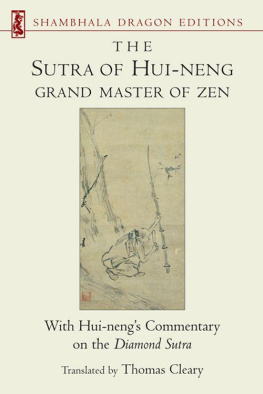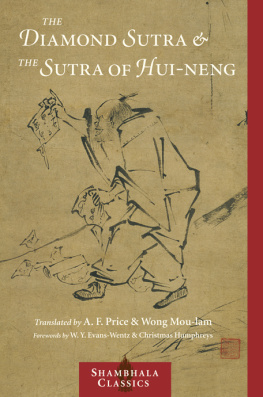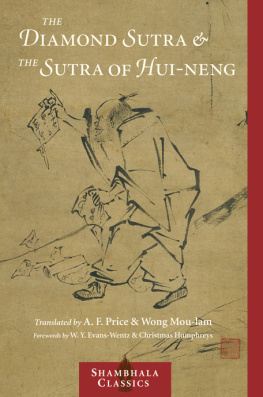The latest work from a distinguished and prolific translator is a new rendering of a celebrated Zen text, The Sutra of Hui-neng. This comes with what is stated to be the first English translation of Hui-nengs verse-by-verse commentary on the Diamond Sutra.
The Middle Way
ABOUT THE BOOK
Hui-neng (638713) is perhaps the most beloved and respected figure in Zen Buddhism. An illiterate woodcutter who attained enlightenment in a flash, he became the Sixth Patriarch of Chinese Zen, and is regarded as the founder of the Sudden Enlightenment school. He is the supreme exemplar of the fact that neither education nor social background has any bearing on the attainment of enlightenment. This collection of his talks, also known as the Platform or Altar Sutra, is the only Zen record of its kind to be generally honored with the appellation sutra, or scripture.
The Sutra of Hui-neng is here accompanied by Hui-nengs verse-by-verse commentary on the Diamond Sutrain its very first published English translation ever.
THOMAS CLEARY holds a PhD in East Asian Languages and Civilizations from Harvard University and a JD from the University of California, Berkeley, Boalt Hall School of Law. He is the translator of over fifty volumes of Buddhist, Taoist, Confucian, and Islamic texts from Sanskrit, Chinese, Japanese, Pali, and Arabic.
Sign up to learn more about our books and receive special offers from Shambhala Publications.

Or visit us online to sign up at shambhala.com/eshambhala.
THE SUTRA OF HUI-NENG
G RAND M ASTER OF Z EN
With Hui-nengs Commentary on the
DIAMOND SUTRA
Translated from the Chinese by
T HOMAS C LEARY

S HAMBHALA
Boston & London
2012
S HAMBHALA P UBLICATIONS , I NC .
H ORTICULTURAL H ALL
300 M ASSACHUSETTS A VENUE
B OSTON , M ASSACHUSETTS 02115
WWW.SHAMBHALA.COM
1998 by Thomas Cleary
Cover art: The Sixth Patriarch Cutting Bamboo (detail), by Liang Kai. Tokyo National Museum, Tokyo, Japan. Reproduced courtesy Kyoryokukai.
All rights reserved. No part of this book may be reproduced in any form or by any means, electronic or mechanical, including photocopying, recording, or by any information storage and retrieval system, without permission in writing from the publisher.
Library of Congress Cataloging-in-Publication Data
Hui-neng, 638713
[Liu-tsu-ta-shih fa pao t an ching. English]
The Sutra of Hui-neng, grand master of Zen/translated from the Chinese by Thomas Cleary.
p. cm.
eISBN 978-0-8348-2541-3
ISBN 978-1-57062-348-6 (pbk. alk. paper)
1. Zen BuddhismDoctrinesEarly works to 1800.
I. Cleary, Thomas F., 1949 . II. Title.
BQ9299.H854L613 1998 98-21143
294.3927dc21 CIP
C ONTENTS
H ui-neng (638713) is a central figure of Zen Buddhist tradition. The last of the early Grand Masters or founding teachers of Zen, Hui-neng is popularly considered the founder of the so-called Southern School of Zen. Hui-neng characterized his teaching as the teaching of immediacy, based on direct insight into the essential nature of awareness. As a testimony of his eminent place in Zen tradition, the record of Hui-nengs life and lectures is the only such document to be dignified with the title of sutra, or scripture, the word traditionally reserved, in Buddhist literature, for the teachings of a buddha.
Hui-neng lived during the Tang dynasty (619906), which is often considered the apogee of Chinese culture. The development of Chinese Buddhism was particularly marked during this era, assisted by imperial patronage. Translators from India, Khotan, Sogdiana, Tocharia, Kucha, and other lands continued the enormous work of rendering the Buddhist canons into Chinese, while great masters of emerging Chinese schools pursued the full articulation of pragmatic syntheses of the teachings.
Hui-neng is traditionally said to have been an illiterate woodcutter from a frontier area. He attained enlightenment as a young man of no account, the story goes, and inherited the rank of Grand Master of Zen. Subsequently he was obliged to flee the persecution of jealous elitists, and he disappeared into the mountains. Hui-neng reemerged in middle age as the last of the Zen founders, finally popularizing the teaching among all classes of people. Although he himself was unlettered and expounded Buddhism in the simplest of terms, Hui-nengs students and disciples included Confucian scholars as well as eminent monks, even a Buddhist canon master from India.
The career of Hui-neng had an incalculable effect on the dissemination of Zen in China. According to the biography of Hui-neng recorded in traditional Zen sources, there were thirty-three people known as formal successors of the Grand Master, who taught Zen openly. There were an unrecorded number of others who attained the teaching, the biography adds, who concealed their names and hid their tracks. The names of ten of these hidden masters have been found, although nothing else is known of them. Besides these forty-three known successors of Hui-neng, Grand Master of Zen, it is also said that countless people awakened to the Way and transcended the ordinary under the impact of his teaching.
Two versions of Hui-nengs sutra, called the Altar Sutra, are readily available today. A manuscript of an older, briefer version attributed to Hui-nengs disciple Fa-hai was discovered among the many works unearthed at Tun-huang. A more detailed version compiled in 1291 was based on a number of texts. It is on this fuller version that the present translation is based.
The compiler of this version of the sutra, a monk named Tsungpao, notes in an afterword to his edition,
The teachings that the Sixth Grand Master used to expound were all the complete all-at-once message of the Great Vehicle; that is why this is called a sutra. The words are everyday, but its guidance is far-reaching; the expression is easy, the meaning is clear. Everyone who reads it gets something from it. Master Ming-chiao praised it by saying, Those whose natural potential is sharp will get the deep, those whose natural potential is dull will get the shallow. How true these words are!
When I first entered the Way, I was inspired by this sutra. Subsequently I saw three different texts of varying quality. The woodblocks were already worn out, so I made a comparison of the texts, correcting errors and filling in abbreviations, also adding the stories of disciples questions, in hopes that those who wish to learn may get the message.

Realization of the Teaching and Inheritance of the Robe
W hen the Great Master came to the Forest of Jewels Monastery, Governor Wei of Shao Province went into the mountains with some government officers to request the Master to come out into the city and preach for the people at the lecture hall of the Great Brahma Monastery.
When the Master took the chair, the governor, over thirty officials, over thirty Confucian scholars, and more than one thousand monks, nuns, and laypeople all bowed at once and asked to hear the essentials of the teaching.
The Great Master said to the crowd,
Good friends, bodhi is inherently pure; just use this mind, and you will directly realize buddhahood.
Good friends, for now listen to the course of events through which I realized the teaching.
My father was originally from Fan-yang, but he was banished to Ling-nan, where he became a peasant in Hsin [New] Province. Unfortunately for me, my father also died early. With my widowed mother I moved to Nan-hai, where we suffered from poverty as I sold firewood for a living.
Next page
















